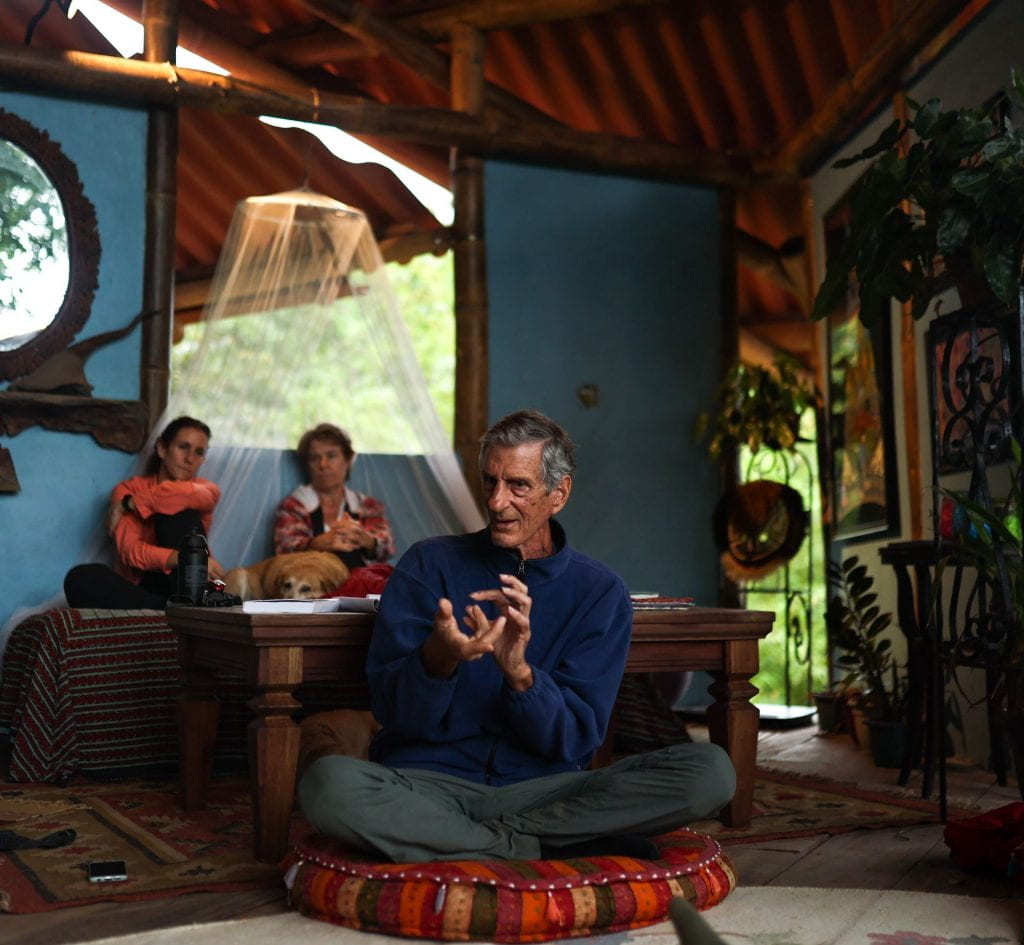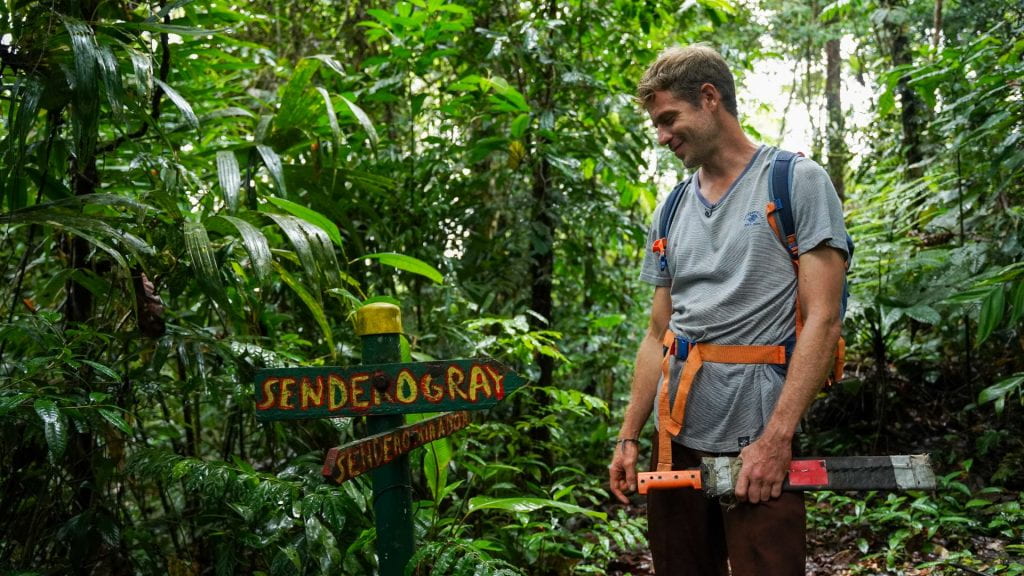“Panama is Pandora.” The real-world inspiration behind the upcoming “Avatar” video game
By Lucas Cooperman and Zoë Bleu Sommers

MAMONí VALLEY, Panama – Stepping between purple ti plants and spiky palm trees, the player enters Pandora, the homeworld of the “Avatar” movie franchise’s indigenous Na’vi people. The graphics are stunning: green plants and moss cover the trees and a small dragon-like animal cuts across the trail. The main difference between Pandora and the jungles of Panama is that on Earth, the insect is a leafcutter ant, not a digitally-created fluorescent creature.
The huge success of 2009’s “Avatar” generated a franchise that boasts a video game and a section of Disney World. The first film, which raked in over $2.8 billion, tells a story of the 22nd-century colonization of the lush moon Pandora by humans, whose mining efforts threaten the existence of the Na’vi tribe. It’s an obvious allusion to the real-world threats of greed and imperialism that plague the planet and its indigenous populations. A sequel to the movie is set to release on Dec. 16 of this year, after multiple delays.
It’s not surprising that Panama and Pandora share such a resemblance. In 2018, as director James Cameron labored over the sequel to his record-breaking blockbuster, a group of 19 photographers, illustrators and storytellers from the French video game company Ubisoft traveled around Panama for 11 days.
Cameron’s original “Avatar” was accompanied by a best-selling video game, but Ubisoft is hoping that with updates in gaming technology and a transition from third- to first-person gameplay, “Avatar: Frontiers of Pandora” will be even more successful. It is currently expected to be released sometime this year.
Much about the development of “Frontiers of Pandora” remains a secret. Representatives from Ubisoft, which produced blockbusters such as “Assassin’s Creed,” “Far Cry” and “Just Dance” – all franchises that have sold hundreds of millions of copies worldwide – declined to comment on the game. But those who hosted the designers during their stay in Panama were not hesitant to talk about the experience and the potential benefits a best-selling game could bring to a region dealing with economic, cultural and climatic pressures.
“I want the game to serve for young people as an introduction into real-world eco change,” said Nathan Gray, the founder and president of Geoversity, a non-profit based in Panama that uses immersive educational and exploration programs to inspire conservation efforts. “Ultimately, I want people to unplug from the game, and tap into the real trees of life.”

Video game companies like Ubisoft typically expect their designers to put in long hours at their keyboards, whether at home or in their offices. But the process behind “Frontiers of Pandora” required designers to unplug their headphones and head out into the field.
During their time in the country, Geoversity was charged with helping the Ubisoft team access typically hard-to-reach places like Emberá-Púrú, a territory of the indigenous Emberá people in Chagres National Park. The ability to step into an undeveloped natural space gave developers a sense of what the landscape in Pandora could look like.
The Ubisoft team trekked through the jungles, rafted through rivers and slogged through ankle-deep mud on Geoversity’s Ridge to Reef program. They weathered steep trails, river rapids and did their best to avoid the region’s bullet ants, which produce a sting so painful it mimics the pain of a gunshot.
The game developers weren’t the only ones inspired by their time in the Panamanian rainforest. Their hosts were as well, and are hoping to turn the exploration into future collaborations. Gray is a lifelong leadership enthusiast, focused on impacting the way young people experience education in hopes to inspire real-world change.
When he heard that the Ubisoft team was scouting Central American locations, Gray’s first instinct was not to get involved, not understanding the magnitude of Ubisoft’s role in the gaming world. It was only after his teenage son told him that Ubisoft’s trip presented a once-in-a-lifetime opportunity that he decided to help.
Enticing the team with Panama’s unique biodiversity and his organization’s relationships with local indigenous communities, Gray quickly convinced them that the country was a must-see. “In such a small country, they could experience so much,” he explained.
Cameron’s interest in the country was also key for the game’s development. In addition to being one of the biggest film directors in the world, Cameron is a climate activist who has repeatedly stressed the importance of taking action – he founded the Avatar Alliance Foundation to tackle climate change, deforestation and indigenous rights, among other global issues.
And finally, on a separate trip apart from Geoversity, the game developers also visited Guna Yala in northwest Panama, an indigenous community that includes multiple islands on which the population lives. There, they experienced firsthand that the themes of “Avatar” are real for tens of thousands of indigenous people struggling against impacts of climate change and rising sea levels.
Paolino Contreras is a saila, or chief, in the Guna community. He resides on the biggest of the four Cartí islands in the region. Their population is currently struggling with overcrowding and there are plans to move hundreds of people from the islands to the mainland. Back in 2018, his community welcomed the Ubisoft team for a visit.
Keeping their community open to visitors is important not only for the money generated by tourism, but for spreading accurate stories about the culture of the Guna people across the world.
“Historically, stories [about us] have not been accurate. They’re written by third parties,” said Contreras. “We welcome people to come and learn firsthand.”

Spreading awareness about indigenous people is valued by members of those communities, which can often be isolated and reliant on word-of-mouth communication to convey their existence to the outside world.
“People from everywhere should know about the Emberá people,” said Suileka Mepaquito, a member of the indigenous Emberá-Púrú community. “We are the caretakers of nature here. It is important to be known.”
Geoversity staff hope that through the Ubisoft team’s incorporation of their Panama experience into the “Avatar” game, the gap between reality and fantasy for young people around the world will lessen, inspiring them to not only care about their connection with nature, but to take action to protect it.
According to Geoversity’s Centro Mamoní manager, Nico Armstrong, stepping into one of the places where “Avatar” derived its inspiration is key to understanding the importance and necessity of conservation: “I can talk to people for hours about the work that we do,” said Armstrong. “But it isn’t comparable to being in the forest.”
According to recent research, well-designed video games offer new opportunities for young people to engage with the issue of climate change, and encourage them to think and act in ways that help to address the problem. However, there is a big difference between educational video games and fantasy games for role-playing. When it comes to Avatar, some gamers feel as though players won’t notice the messaging that Geoversity is betting on.
“There could be a bit of responsibility to push the communication [that Ubisoft was directly inspired by Panama]. It’s important because people will easily overlook that,” explained Quinn Arbolante, a member of Northeastern University’s “Counter-Strike: Global Offensive” e-sports club team and avid gamer.
“Players will say ‘wow, this is a cool game,’ but won’t make many connections to the real world past that… Who would connect Panama to Avatar?” wondered Arbolante. “You do have to try to promote that this is a real place, but it’s hard, because the Avatar world is already fantasy.”
For some, the connection between the fantasy world of “Avatar” and real-world issues can be hard to find. Armstrong acknowledged that the point of the movie is for people to think about humanity’s role in the world but thought that “most viewers don’t have the intended takeaway.”
Experts say that the mere allusion to real-world issues isn’t all creators can do to raise awareness and support for them. If there’s a specific cause that creators are trying to educate about, “There should be something done to leverage [the movie’s] impact,” said Alan Rosenblatt, a digital media expert from Arlington, Virginia, communications professor and the strategic advisor behind Cameron’s first foray into using Twitter as a platform to promote both Avatar and climate change activism.
In Rosenblatt’s opinion, Cameron’s massive platform can draw attention to the causes that he is inspired by. And he’s used it: For two seasons, Cameron was an executive producer for the documentary series, “Years of Living Dangerously.” The show, which ran on Showtime in 2014 and National Geographic in 2016, featured celebrity hosts such as David Letterman, Jack Black and Jessica Alba traveling around the world to show how climate change was impacting different communities.
Sharing stories that are directly drawn from the real world actually adds a layer of appeal, said Rosenblatt. For that reason, it might be a good marketing idea to share about the landscapes that inspired the “Avatar” franchise. “It’s stupid not to share real-world inspiration,” said Rosenblatt. “It makes the story more compelling.”
Only time will tell if the game will inspire players to visit Panama, or at least consider the real-life issues the country is facing. But, it still has the ability to inspire change. “I think the game has the potential to do all kinds of ancillary work,” said Gray. “The ‘Avatar’ experience will take this flurry of interest and make you want to do more.”

For his part, Cameron already is doing more. The MUSE School, founded by Cameron’s wife, Suzy Amis Cameron, and her sister, Rebecca, is a private school that has the bold mission of revolutionizing education and sustainability.
Nestled in the Santa Monica mountains of Calabasas, California, MUSE supports about 115 students from pre-kindergarten to 12th grade. The vision, according to the head of school, Suzanne McClure, is that after a MUSE education, “students are going to be one with themselves, their community and the planet.”
Included in this vision are the instilled values of sustainability, flexibility and interconnectedness. But these can’t be achieved without real-world experiences. “The more that we have students step into the real world, the more they travel and meet different people, see different cultures, that is the real learning in our eyes,” said McClure.
While MUSE’s reach is still quite narrow, there are many opportunities for growth in the coming years. Already, the school hosted a summit inviting representatives from the Panamanian government, Stanford University and Geoversity to discuss how each institution could work together moving forward.
Soon, McClure said that she’ll be traveling to Mamoní Valley herself to develop more of the plans that came out of the brainstorming session with Gray. In the meantime, the “Avatar” game and upcoming sequels might be Camerons’ best bet for expanding the reach of messages about sustainability and conservation.
“[This game] will impact young people. There’s potential here to make a structural systemic difference,” said Gray. “We want to ultimately get those kids away from the screen and into nature. We can’t lose this generation.”
Disclosure: Geoversity hosted Northeastern University for a week in late May/early June at its site in the Mamoní Valley.